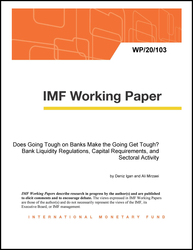
Does Going Tough on Banks Make the Going Get Tough? Bank Liquidity Regulations, Capital Requirements, and Sectoral Activity
Does Going Tough on Banks Make the Going Get Tough? Bank Liquidity Regulations, Capital Requirements, and Sectoral Activity
READ MORE...
Volume/Issue:
Volume 2020
Issue 103
Publication date: June 2020
ISBN: 9781513548104
$18.00
Add to Cart by clicking price of the language and format you'd like to purchase
Available Languages and Formats
| English |
Prices in red indicate formats that are not yet available but are forthcoming.
Topics covered in this book
This title contains information about the following subjects.
Click on a subject if you would like to see other titles with the same subjects.
Banks and Banking , Finance , WP , capital level , economic activity , capital requirement , capital position , investment rate , liquidity level , return on equity , capital standard , net income , Liquidity requirements , Liquidity , Capital adequacy requirements , Basel III , Global , Bank liquidity , bank capital , Financial stability , Sectoral activity , external finance dependence ,
Summary
Whether and to what extent tougher bank regulation weighs on economic growth is an open empirical question. Using data from 28 manufacturing industries in 50 countries, we explore the extent to which cross-country differences in bank liquidity and capital levels were related to differences in sectoral activity around the period of the global financial crisis. We find that industries which are more dependent on external finance, in countries where banks had higher liquidity and capital ratios, performed relatively better during the crisis, with regard to investment rates and the creation of new enterprises. This relationship, however, exists only for bank-based systems and emerging market economies. In the pre-crisis period, we find only a marginal link to bank capital. These findings survive a battery of robustness checks and provide some solid support for the tighter prudential measures introduced under Basel III.
Copyright © 2010 - 2024
Powered by:
AIDC



